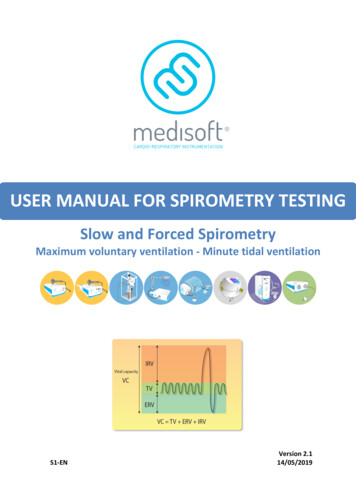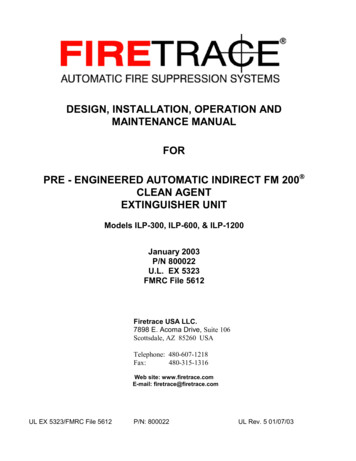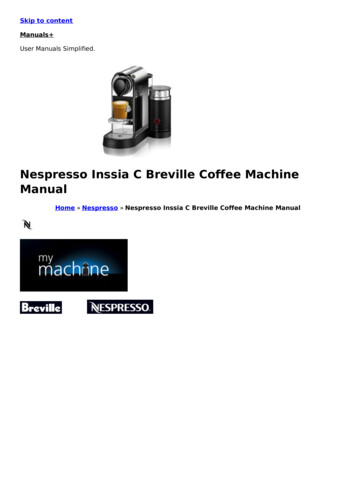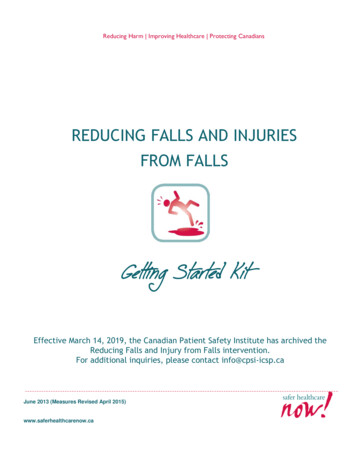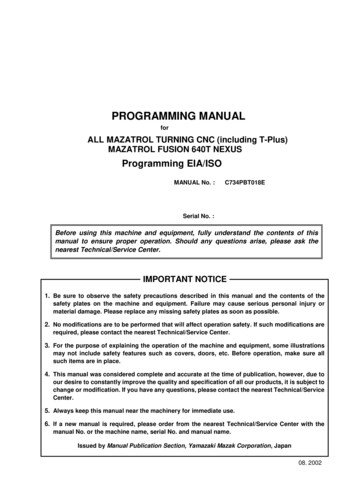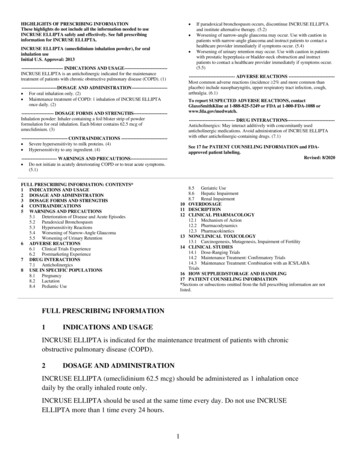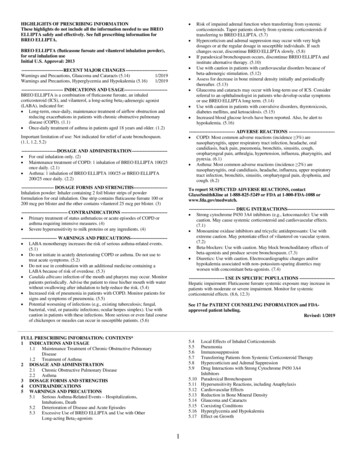
Transcription
4. Contraindications and PrecautionsUpdatesMajor changes to the best practice guidance in this section include 1) enhancement of thedefinition of a “precaution” to include any condition that might confuse diagnosticaccuracy and 2) recommendation to vaccinate during a hospitalization if a patient is notacutely moderately or severely ill.General PrinciplesNational standards for pediatric vaccination practices have been established and includedescriptions of valid contraindications and precautions to vaccination (2). Persons whoadminister vaccines should screen patients for contraindications and precautions to thevaccine before each dose of vaccine is administered (Table 4-1). Screening is facilitated byconsistent use of screening questionnaires, which are available from certain statevaccination programs and other sources (e.g., the Immunization Action nsContraindications (conditions in a recipient that increases the risk for a serious adversereaction) to vaccination are conditions under which vaccines should not be administered.Because the majority of contraindications are temporary, vaccinations often can beadministered later when the condition leading to a contraindication no longer exists. Avaccine should not be administered when a contraindication is present; for example,MMR vaccine should not be administered to severely immunocompromised persons (1).However, certain conditions are commonly misperceived as contraindications (i.e., arenot valid reasons to defer vaccination).Severely immunocompromised persons generally should not receive live vaccines (3).Because of the theoretical risk to the fetus, women known to be pregnant generally shouldnot receive live, attenuated virus vaccines (4). Persons who experienced encephalopathywithin 7 days after administration of a previous dose of pertussis- containing vaccine notattributable to another identifiable cause should not receive additional doses of a vaccinethat contains pertussis (4,5).General Best Practice Guidelines for Immunization: Contraindications and Precautions51
Severe Combined Immunodeficiency (SCID) disease and a history of intussusception areboth contraindications to the receipt of rotavirus vaccines (6).PrecautionsA precaution is a condition in a recipient that might increase the risk for a serious adversereaction, might cause diagnostic confusion, or might compromise the ability of thevaccine to produce immunity (e.g., administering measles vaccine to a person withpassive immunity to measles from a blood transfusion administered up to 7 monthsprior) (7). A person might experience a more severe reaction to the vaccine than wouldhave otherwise been expected; however, the risk for this happening is less than the riskexpected with a contraindication. In general, vaccinations should be deferred when aprecaution is present. However, a vaccination might be indicated in the presence of aprecaution if the benefit of protection from the vaccine outweighs the risk for an adversereaction.The presence of a moderate or severe acute illness with or without a fever is aprecaution to administration of all vaccines (Table 4-1). The decision to administer ordelay vaccination because of a current or recent acute illness depends on the severity ofsymptoms and etiology of the condition. The safety and efficacy of vaccinating personswho have mild illnesses have been documented (8-11). Vaccination should be deferredfor persons with a moderate or severe acute illness. This precaution avoids causingdiagnostic confusion between manifestations of the underlying illness and possibleadverse effects of vaccination or superimposing adverse effects of the vaccine on theunderlying illness. After they are screened for contraindications, persons withmoderate or severe acute illness should be vaccinated as soon as the acute illness hasimproved. Studies indicate that failure to vaccinate children with minor illnesses canimpede vaccination efforts (12–14). Among persons whose compliance with medicalcare cannot be ensured, use of every opportunity to administer appropriate vaccines iscritical.Hospitalization should be used as an opportunity to provide recommended vaccinations.Health-care facilities are held to standards of offering influenza vaccine for hospitalizedpatients, so providers are incentivized to vaccinate these patients at some point duringhospitalization (15). Likewise, patients admitted for elective procedures will not beacutely ill during all times during their hospitalization. Most studies that have exploredGeneral Best Practice Guidelines for Immunization: Contraindications and Precautions52
the effect of surgery or anesthesia on the immune system were observational, includedonly infants and children, and were small and indirect, in that they did not look at theimmune effect on the response to vaccination specifically (16-35). They do not provideconvincing evidence that recent anesthesia or surgery significantly affect response tovaccines. Current, recent, or upcoming anesthesia/surgery/hospitalization is not acontraindication to vaccination, but certain factors might lead a provider to considercurrent, recent, or upcoming anesthesia/surgery/hospitalization as a precaution (16-35).Efforts should be made to ensure vaccine administration during the hospitalization or atdischarge. For patients who are deemed moderately or severely ill throughout thehospitalization, vaccination should occur at the earliest opportunity (i.e., duringimmediate post-hospitalization follow-up care, including home or office visits) whenpatients’ clinical symptoms have improved.A personal or family history of seizures is a precaution for MMRV vaccination; this isbecause a recent study found an increased risk for febrile seizures in children 12-23months who receive MMRV compared with MMR and varicella vaccine (36).Neither Contraindications Nor PrecautionsClinicians or other health-care providers might misperceive certain conditions orcircumstances as valid contraindications or precautions to vaccination when theyactually do not preclude vaccination (2) (Table 4-2). These misperceptions result inmissed opportunities to administer recommended vaccines (37).Routine physical examinations and procedures (e.g., measuring temperatures) are notprerequisites for vaccinating persons who appear to be healthy. The provider should askthe parent or guardian if the child is ill. If the child has a moderate or severe illness, thevaccination should be postponed.General Best Practice Guidelines for Immunization: Contraindications and Precautions53
TABLE 4-1. Contraindications and precautions(a) to commonly used vaccinesVaccineCitation ContraindicationsDengue–(38)ONLY use inpersons whohavelaboratoryconfirmationof previousdengueinfectionAND residein endemicdengue areasLack of laboratoryevidence of previousdengue infectionDT, TdSevere allergic reaction(e.g., anaphylaxis) aftera previous dose or to avaccine component(b)(4)Severe allergic reaction(e.g., anaphylaxis) aftera previous dose or to avaccine componentPrecautionsPregnancyHIV infection without evidence ofsevere immunosuppressionModerate or severe acute illnesswith or without feverSevereimmunodeficiency (e.g.,hematologic and solidtumors, receipt mimmunosuppressivetherapy(c) or patientswith HIV infection whoare severelyimmunocompromised)GBS 6 weeks after previous dose oftetanus-toxoid–containing vaccineHistory of Arthus-typehypersensitivity reactions after aprevious dose of diphtheria-toxoid—containing or tetanus-toxoid–containing vaccine; defer vaccinationuntil at least 10 years have elapsedsince the last tetanus-toxoidcontaining vaccineModerate or severe acute illness withor without feverGeneral Best Practice Guidelines for Immunization: Contraindications and Precautions54
DTaP(39)Severe allergic reaction(e.g., anaphylaxis) aftera previous dose or to avaccine componentEncephalopathy (e.g.,coma, decreased level ofconsciousness,prolonged seizures), notattributable to anotheridentifiable cause,within 7 days ofadministration ofprevious dose of DTP orDTaPProgressive neurologic disorder,including infantile spasms,uncontrolled epilepsy, progressiveencephalopathy; defer DTaP untilneurologic status clarified andstabilizedModerate or severe acute illness withor without feverGBS 6 weeks after previous dose oftetanus-toxoid–containing vaccineHistory of Arthus-typehypersensitivity reactions after aprevious dose of diphtheria-toxoid–containing or tetanus-toxoid–containing vaccine; defer vaccinationuntil at least 10 years have elapsedsince the last tetanus-toxoid–containing vaccineModerate or severe acute illness withor without feverHepatitis A(40)Severe allergic reaction(e.g., anaphylaxis) aftera previous dose or to avaccine componentHepatitis B(41)Severe allergic reaction Moderate or severe acute illness with(e.g., anaphylaxis) after or without fevera previous dose or to avaccine componentHypersensitivity to yeastHib(42)Severe allergic reaction(e.g., anaphylaxis) afterModerate or severe acute illness withor without feverGeneral Best Practice Guidelines for Immunization: Contraindications and Precautions55
a previous dose or to avaccine componentAge 6 weeksHPV(d)(43)Severe allergic reaction(e.g., anaphylaxis) aftera previous dose or to avaccine component,including yeastModerate or severe acute illness withor without feverIIV(e)(44)Severe allergic reaction(e.g., anaphylaxis) afterprevious dose ofinfluenza vaccine or tovaccine componentGBS 6 weeks after a previous dose ofinfluenza vaccineModerate or severe acute illness withor without feverEgg allergy other than hives, e.g.,angioedema, respiratory distress,lightheadedness, recurrent emesis; orrequired epinephrine or anotheremergency medical intervention (IIVmay be administered in an inpatient oroutpatient medical setting and underthe supervision of a health careprovider who is able to recognize andmanage severe allergic conditions).IPV(45)Severe allergic reaction(e.g., anaphylaxis) aftera previous dose or to avaccine componentPregnancyModerate or severe acute illness withor without feverGeneral Best Practice Guidelines for Immunization: Contraindications and Precautions56
LAIV(f)(44)Severe allergic reaction(e.g., anaphylaxis) aftera previous dose or to avaccine componentConcomitant use ofaspirin or salicylatecontaining medicationin children andadolescentsLAIV4 should not beadministered to personswho have takenoseltamivir or zanamivirwithin the previous 48hours, peramivir withinthe previous 5 days, orbaloxavir within theprevious 17 days.(h)GBS 6 weeks after a previous dose ofinfluenza vaccineAsthma in persons aged 5 years old orolderMedical conditions which mightpredispose to higher risk ofcomplications attributable toinfluenza(g)Moderate or severe acute illness withor without feverPregnancyChildren aged 2 through4 years who havereceived a diagnosis ofasthma or whoseparents or caregiversreport that a health careprovider has told themduring the preceding 12months that their childhad wheezing or asthmaor whose medical recordindicates a wheezingepisode has occurredduring the preceding 12months.Persons with ns/leaks.General Best Practice Guidelines for Immunization: Contraindications and Precautions57
Close contacts andcaregivers of severelyimmunosuppressedpersons who require aprotected environment.Persons with cochlearimplants (due to thepotential for CSF leak,which might exist forsome period of timeafter implantation.Providers mightconsider consultationwith a specialistconcerning risk ofpersistent CSF leak if anage-appropriateinactivated orrecombinant vaccinecannot be used).AlteredImmunocompetenceAnatomic or functionalasplenia (e.g. sickle celldiseaseMenACWY(46)Severe allergic reaction(e.g., anaphylaxis) aftera previous dose or to avaccine component,including yeastModerate or severe acute illness withor without feverPreterm birth (MenACWY-CRM)(i)MenB(46,48)Severe allergic reaction(e.g., anaphylaxis) aftera previous dose or to avaccine componentModerate or severe acute illness withor without feverPregnancyLatex sensitivity (MenB-4c)General Best Practice Guidelines for Immunization: Contraindications and Precautions58
MMR(j),(k)(1)Severe allergic reaction(e.g., anaphylaxis) aftera previous dose or to avaccine componentPregnancyKnown severeimmunodeficiency (e.g.,from hematologic andsolid tumors, receipt mimmunosuppressivetherapy(c) or patientswith HIV infection whoare severelyimmunocompromised)Family history of alteredimmunocompetence(m)Recent ( 11 months) receipt ofantibody-containing blood product(specific interval depends on product)History of thrombocytopenia orthrombocytopenic purpuraNeed for tuberculin skin testing orinterferon-gamma release assay(IGRA) testing(l)Moderate or severe acute illness withor without feverMPSV4(49)Severe allergic reaction(e.g., anaphylaxis) aftera previous dose or to avaccine componentModerate or severe acute illness withor without feverPCV13(50)Severe allergic reaction(e.g., anaphylaxis) aftera previous dose ofPCV13 or anydiphtheria-toxoid–containing vaccine or toa component of avaccine (PCV13 or anydiphtheria-toxoid–containing vaccine),including yeastModerate or severe acute illness withor without feverPPSV23(51)Severe allergic reaction(e.g., anaphylaxis) after aprevious dose or to avaccine componentModerate or severe acute illness withor without feverRIV(44)Severe allergic reaction(e.g., anaphylaxis) to anycomponent of thevaccineGBS 6 weeks after a previous dose ofinfluenza vaccineModerate or severe acute illness withor without feverGeneral Best Practice Guidelines for Immunization: Contraindications and Precautions59
Rotavirus(6)Severe allergic reaction(e.g., anaphylaxis) after aprevious dose or to avaccine componentSCIDHistory ofintussusceptionAltered immunocompetence otherthan SCIDChronic gastrointestinal disease(n)Spina bifida or bladder exstrophy(n)Moderate or severe acute illness withor without feverTdap(52)Severe allergic reaction(e.g., anaphylaxis) after aprevious dose or to avaccine componentEncephalopathy (e.g.,coma, decreased level ofconsciousness, prolongedseizures), not attributableto another identifiablecause, within 7 days ofadministration ofprevious dose of DTP,DTaP, or TdapGBS 6 weeks after a previous dose oftetanus-toxoid–containing vaccineProgressive or unstable neurologicaldisorder, uncontrolled seizures, orprogressive encephalopathy until atreatment regimen has beenestablished and the condition hasstabilizedHistory of Arthus-typehypersensitivity reactions after aprevious dose of diphtheria-toxoid—containing or tetanus-toxoid–containing vaccine; defer vaccinationuntil at least 10 years have elapsedsince the last tetanus-toxoid–containing vaccineModerate or severe acute illness withor without feverVaricella(j),(k (53)Severe allergic reaction(e.g., anaphylaxis) after aprevious dose or to avaccine componentKnown severeimmunodeficiency (e.g.,from hematologic andsolid tumors, receipt ofchemotherapy,congenitalimmunodeficiency, longterm immunosuppressivetherapy(c) or patients withHIV infection who areseverelyimmunocompromised)(j)Recent ( 11 months) receipt ofantibody-containing blood product(specific interval depends on product)Moderate or severe acute illness withor without fever)Receipt of specific antiviral drugs(acyclovir, famciclovir, orvalacyclovir) 24 hours beforevaccination (avoid use of theseantiviral drugs for 14 days aftervaccination)Use of aspirin or aspirin-containingproducts(o)PregnancyFamily history of alteredimmunocompetence(m)General Best Practice Guidelines for Immunization: Contraindications and Precautions60
Zoster(54)Severe allergic reaction(e.g., anaphylaxis) after aprevious dose or to avaccine componentModerate or severe acute illness withor without feverAbbreviations: DT diphtheria and tetanus toxoids; DTaP diphtheria and tetanus toxoids and acellular pertussis;DTP diphtheria toxoid, tetanus toxoid, and pertussis; GBS Guillain-Barré syndrome; Hib Haemophilus influenzaetype b; HIV human immunodeficiency virus; HPV human papillomavirus; IIV inactivated influenza vaccine; IPV inactivated poliovirus; LAIV live, attenuated influenza vaccine; MenACWY quadrivalent meningococcal conjugatevaccine; MMR measles, mumps, and rubella; MPSV4 quadrivalent meningococcal polysaccharide vaccine; PCV13 pneumococcal conjugate vaccine; PPSV23 pneumococcal polysaccharide vaccine; SCID severe combinedimmunodeficiency; RIV recombinant influenza vaccine; Td tetanus and diphtheria toxoids; Tdap tetanus toxoid,reduced diphtheria toxoid, and acellular pertussis.(a) Eventsor conditions listed as precautions should be reviewed carefully. Benefits of and risks for administering aspecific vaccine to a person under these circumstances should be considered. If the risk from the vaccine is believed tooutweigh the benefit, the vaccine should not be administered. If the benefit of vaccination is believed to outweigh therisk, the vaccine should be administered. Whether and when to administer DTaP to children with proven or suspectedunderlying neurologic disorders should be decided on a case-by-case basis.(b) Onlypersons with laboratory confirmation of immunity according to strict guidance tml should receive dengue vaccination.(c) Substantiallyimmunosuppressive steroid dose is considered to be 2 weeks of daily receipt of 20 mg or 2 mg/kg bodyweight of prednisone or equivalent.(d) HPVvaccine is not recommended during pregnancyWhen applying this contraindication to ccIIV, the history of severe allergic reaction (e.g., anaphylaxis) must be specificto the event occurring following a dose of ccIIV. Likewise, when applying this contraindication to RIV, the history ofsevere allergic reaction (e.g., anaphylaxis) must be specific to the event occurring following a dose of RIV. A history ofsevere allergic reaction (e.g., anaphylaxis) to a non-ccIIV vaccine or to a component specific to components notcontained in ccIIV, is a precaution to ccIIV. A history of severe allergic reaction (e.g., anaphylaxis) to a non-RIV vaccineor to a component specific to components not contained in RIV is a precaution to RIV.(e)(f) In addition, ACIP recommends LAIV not be used for pregnant women, immunosuppressed persons, and children aged2-4 years who have asthma or who have had a wheezing episode noted in the medical record within the past 12 months,or for whom parents report that a health care provider stated that they had wheezing or asthma within the last 12 months.LAIV should not be administered to persons who have taken influenza antiviral medications within the previous 48hours. Persons who care for severely immunosuppressed persons who require a protective environment should notreceive LAIV, or should avoid contact with such persons for 7 days after receipt.(g) Seereference: Grohskopf LA, Alyanak E, Ferdinands JM, et al. Prevention and Control of Seasonal Influenza withVaccines: Recommendations of the Advisory Committee on Immunization Practices, United States, 2021-2022 InfluenzaSeason. MMWR Recomm Rep 2021;70(No. RR-5):1-30.General Best Practice Guidelines for Immunization: Contraindications and Precautions61
These values are based on the clearance of the particular antiviral. LAIV4 should not be administered to persons whohave taken oseltamivir or zanamivir within the previous 48 hours, peramivir within the previous 5 days, or baloxavirwithin the previous 17 days. This “contraindication” is due to concern with reduced effectiveness of the vaccine. To obtainspecific information, please refer to Grohskopf LA, Alyanak, E, Broder KR, et. al. Prevention and Control of SeasonalInfluenza with Vaccines: Recommendations of the Advisory Committee on Immunization Practices — United States,2020–21 Influenza Season. MMWR Recomm Rep 2020;69 (No. RR-8:1-26. Also 08a1-H.pdf(h)(i) Thisprecaution applies to infants younger than 9 months old(j) HIV-infectedchildren may receive varicella vaccine if CD4 T-lymphocyte count is 15% and should receive MMRvaccine if they are aged 12 months and do not have evidence of current severe immunosuppression (i.e., individualsaged 5 years must have CD4 T lymphocyte [CD4] percentages 15% for 6 months; and individuals aged 5 years musthave CD4 percentages 15% and CD4 200 lymphocytes/mm3 for 6 months) or other current evidence of measles,rubella, and mumps immunity. In cases when only CD4 cell counts or only CD4 percentages are available for thoseolder than age 5 years, the assessment of severe immunosuppression can be based on the CD4 values (count orpercentage) that are available. In cases when CD4 percentages are not available for those aged 5 years, the assessmentof severe immunosuppression can be based on age-specific CD4 counts at the time CD4 counts were measured; i.e.,absence of severe immunosuppression is defined as 6 months above age-specific CD4 count criteria: CD4 count 750lymphocytes/mm3 while aged 12 months and CD4 count 500 lymphocytes/mm3 while aged 1 through 5 years.Sources: (1,50).(k) MMR and varicella-containing vaccines can be administered on the same day. If not administered on the sameday, these vaccines should be separated by at least 28 days.(l) Ifactive tuberculosis is suspected, MMR should be delayed. Measles vaccination might suppress tuberculin reactivitytemporarily. Measles-containing vaccine can be administered on the same day as tuberculin skin or IGRA testing. Iftesting cannot be performed until after the day of MMR vaccination, the test should be postponed for 4 weeks after thevaccination. If an urgent need exists to skin test or IGRA, do so with the understanding that reactivity might be reducedby the vaccine.(m) familyhistory of congenital or hereditary immunodeficiency in first-degree relatives (e.g., parents and siblings),unless the immune competence of the potential vaccine recipient has been substantiated clinically or verified by alaboratory(n) For RV1 only, based on latex in product/packaging. Note that anaphylactic allergy to latex is covered in thecontraindication, and would also be isolated to RV 1 in the case of latex. For more details, see (55).(o) Noadverse events associated with the use of aspirin or aspirin-containing products after varicella vaccination havebeen reported; however, the vaccine manufacturer recommends that vaccine recipients avoid using aspirin or aspirincontaining products for 6 weeks after receiving varicella vaccines because of the association between aspirin use andReye syndrome after varicella. Vaccination with subsequent close monitoring should be considered for children who haverheumatoid arthritis or other conditions requiring therapeutic aspirin. The risk for serious complications associated withaspirin is likely to be greater in children in whom natural varicella develops than it is in children who receive the vaccinecontaining attenuated VZV. No association has been documented between Reye syndrome and analgesics or antipyreticsthat do not contain aspirin.”General Best Practice Guidelines for Immunization: Contraindications and Precautions62
TABLE 4-2. Conditions incorrectly perceived as contraindications orprecautions to vaccination (i.e., vaccines may be given under theseconditions)VaccineConditions commonly misperceived ascontraindications or precautionsGeneral for allvaccines, includingDTaP, pediatricDT, adult Td,adolescent-adultTdap, IPV, MMR,Hib, hepatitis A,hepatitis B,varicella, rotavirus,PCV13, IIV, LAIV,PPSV23,MenACWY, MPSV4,HPV, and herpeszosterMild acute illness with or without feverDTaPFever within 48 hours after vaccination with a previous dose ofDTP or DTaPCollapse or shock-like state (i.e., hypotonic hyporesponsiveepisode) within 48 hours after receiving a previous dose ofDTP/DTaPSeizure 3 days after receiving a previous dose of DTP/DTaPPersistent, inconsolable crying lasting 3 hours within 48hours after receiving a previous dose of DTP/DTaPFamily history of seizuresFamily history of sudden infant death syndromeFamily history of an adverse event after DTP or DTaPadministrationStable neurologic conditions (e.g., cerebral palsy, wellcontrolled seizures, or developmental delay)PregnancyAutoimmune disease (e.g., systemic lupus erythematosus orrheumatoid arthritis)ImmunosuppressionPrevious equivocal or abnormal Papanicolaou testKnown HPV infectionBreastfeedingHistory of genital wartsHepatitis BHPVIIVIPVLack of previous physical examination in well-appearingpersonCurrent antimicrobial therapy(a)Convalescent phase of illnessPreterm birth (hepatitis B vaccine is an exception in certaincircumstances)(b)Recent exposure to an infectious diseaseHistory of penicillin allergy, other nonvaccine allergies,relatives with allergies, or receiving allergen extractimmunotherapyHistory of GBS(c)Nonsevere (e.g., contact) allergy to latex, thimerosal, or eggConcurrent administration of Coumadin (generic: warfarin) oraminophyllinePrevious receipt of 1 dose of oral polio vaccineGeneral Best Practice Guidelines for Immunization: Contraindications and Precautions63
are providers that see patients with chronic diseasesor altered immunocompetence (an exception is providers forseverely immunocompromised patients requiring care in aprotected environment)BreastfeedingContacts of persons with chronic disease or alteredimmunocompetence (an exception is contacts of severelyimmunocompromised patients requiring care in a protectedenvironment)Positive tuberculin skin testSimultaneous tuberculin skin or interferon-gamma releaseassay (IGRA) testing(f)BreastfeedingPregnancy of recipient’s mother or other close or householdcontactRecipient is female of child-bearing ageImmunodeficient family member or household contactAsymptomatic or mildly symptomatic HIV infectionAllergy to eggsHistory of invasive pneumococcal disease or pneumoniaPrematurityImmunosuppressed household contactsPregnant household contactsHistory of fever of 40.5 C ( 105 F) for 48 hours aftervaccination with a previous dose of DTP or DTaPHistory of collapse or shock-like state (i.e., hypotonichyporesponsive episode) within 48 hours after receiving aprevious dose of DTP/DTaPHistory of seizure 3 days after receiving a previous dose ofDTP/DTaPHistory of persistent, inconsolable crying lasting 3 hourswithin 48 hours after receiving a previous dose of DTP/DTaPHistory of extensive limb swelling after DTP/DTaP/Td that isnot an Arthus-type reactionHistory of stable neurologic disorderHistory of brachial neuritisLatex allergy that is not y of recipient’s mother or other close or householdcontactImmunodeficient family member or household contact(g)Asymptomatic or mildly symptomatic HIV infectionHumoral immunodeficiency (e.g., agammaglobulinemia)General Best Practice Guidelines for Immunization: Contraindications and Precautions64
ZosterTherapy with low-dose methotrexate ( 0.4 mg/kg/week),azathioprine ( 3.0 mg/kg/day), or 6-mercaptopurine ( 1.5mg/kg/day) for treatment of rheumatoid arthritis, psoriasis,polymyositis, sarcoidosis, inflammatory bowel disease, or otherconditionsHealth-care providers of patients with chronic diseases oraltered immunocompetenceContacts of patients with chronic diseases or alteredimmunocompetenceUnknown or uncertain history of varicella in a U.S.-bornpersonAbbreviations: DT diphtheria and tetanus toxoids; DTP diphtheria toxoid, tetanus toxoid, and pertussis;DTaP diphtheria and tetanus toxoids and acellular pertussis; GBS Guillain-Barré syndrome; HBsAg hepatitisB surface antigen; Hib Haemophilus influenzae type b; HIV human immunodeficiency virus; HPV humanpapillomavirus; IIV inactivated influenza vaccine; IPV inactivated poliovirus; LAIV live, attenuated influenzavaccine; MenACWY quadrivalent meningococcal conjugate vaccine; MMR measles, mumps, and rubella;MPSV4 quadrivalent meningococcal polysaccharide vaccine; PCV pneumococcal conjugate vaccine; PPSV23 pneumococcal polysaccharide vaccine; Td tetanus and diphtheria toxoids; Tdap tetanus toxoid, reduceddiphtheria toxoid, and acellular pertussis.(a) Antibacterialdrugs might interfere with Ty21a oral typhoid vaccine, and certain antiviral drugs might interferewith varicella-containing vaccines and LAIV4.(b) Hepatitis B vaccination should be deferred for infants weighing 2,000 g if the mother is documented to beHBsAg negative. Vaccination should commence at chronological age 1 month or at hospital discharge. For infantsborn to HBsAg-positive women, hepatitis B immune globulin and hepatitis B vaccine should be administeredwithin 12 hours after birth, regardless of weight.(c) An exception is Guillain-Barré syndrome within 6 weeks of a dose of influenza vaccine or tetanus-toxoid–containing vaccine, which are precautions for influenza vaccines and tetanus-toxoid containing vaccines,respectively.(d) MMRand varicella vaccines can be administered on the same day. If not administered on the same day, thesevaccines should be separated by at least 28 days.(e) HIV-infectedchildren should receive immune globulin after exposure to measles. HIV-infected children canreceive varicella and measles vaccine if CD4 T-lymphocyte count is 15%. (55).(f) Measles vaccination might suppress tuberculin reactivity temporarily. Measles-containing vaccine can beadministered on the same day as tuberculin skin or IGRA testing. If testing cannot be performed until after the dayof MMR vaccination, the test should be postponed for at least 4 weeks after the vaccination. If an urgent needexists to skin test or IGRA, do so with the understanding that reactivity might be reduced by the vaccine.(g) If a vaccinee exper
General Best Practice Guidelines for Immunization: Contraindications and Precautions 53 . the effect of surgery or anesthesia on the immune system were observational, included

